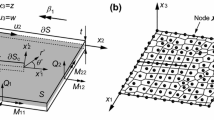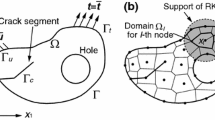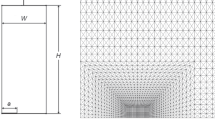Abstract
A fully automatic advancing front type mesh generator to take care of crack problems has been presented. It is coupled with the Zienkiewicz and Zhu error estimator and the refinement methodology depends on the concept of strain energy concentration for completely automatic adaptive analysis of mixed-mode crack problems. For the first time energy based path independent M 1-integral has been used to extract mixed-mode stress intensity factors in randomly changing quadratic triangular meshes. To fulfill the objective of automatic adaptive procedures, an approach has been suggested and validated for generation of integration paths automatically without user intervention. Stress intensity factors have been obtained within engineering accuracy.
Similar content being viewed by others
References
Lo, S.H. and Lee, C.K. (1992). Solving crack problems by an adaptive refinement procedure. Engineering Fracture Mechanics 71, 147-163.
Zienkiewicz, O.C. and Zhu, J.Z. (1987). A simple error estimator and adaptive procedure for practical engineering analysis. International Journal for Numerical Methods in Engineering 25, 337-357.
Lee, C.K. and Lo, S.H. (1992). An automatic adaptive refinement finite element procedure for 2D elastostatic analysis. International Journal for Numerical Methods in Engineering 35, 1967-1989.
Akira Tezuka (1996). 2D Mesh generation scheme for adaptive remeshing process in finite element method. Japan Society of Mechanical Engineers A39, 204-215.
Peraire, J., Vahdati, M., Morgan, K. and Zienkiewicz, O.C. (1987). Adaptive remeshing for compressible flow computations. Journal of Computaional Physics 72, 449-466.
Peraire, J., Peiro, J., Formaggia, L., Morgan, K. and Zienkiewicz, O.C. (1988). Finite element Euler computations in three dimensions. International Journal for Numerical Methods in Engineering 26, 2135-2159.
Zhu, J.Z., Zienkiewicz, O.C., Hinton, E. and Wu, J. (1991). A new approach to the development of automatic quadrilateral mesh generation. International Journal for Numerical Methods in Engineering 32, 849-866.
Sienz, J. and Hinton, E. (1997). Reliable structural optimization with error estimation, adaptivity and robust sensitivity analysis. Computers and Structures 64, 31-63.
Zienkiewicz, O.C. and Zhu, J.Z. (1991). Adaptivity and mesh generation. International Journal for Numerical Methods in Engineering 32, 783-810.
Saouma, V.E. and Schwemmer, D. (1984). Numerical evaluation of the quarter-point crack tip elements. International Journal for Numerical Methods in Engineering 20, 1629-1641.
Harrop, L.P. (1982). The optimum size of quarter point crack tip elements. International Journal for Numerical Methods in Engineering 18, 1101-1103.
Babuska, I., Strouboulis, T. and Upadhyay, C.S. (1997). A model study of the quality of a posterior error estimators for finite element solutions of linear elliptic problems, with particular reference to the behavior near the boundary. International Journal for Numerical Methods in Engineering 40, 2521-2577.
Zienkiewicz, O.C. and Zhu, J.Z. (1989). Error estimates and adaptive refinement for plate bending problems. International Journal for Numerical Methods in Engineering 28, 2839-2853.
Hinton, E., Ozakca, M. and Rao, N.V.R. (1991). Adaptive analysis of thin shells using facet elements. International Journal for Numerical Methods in Engineering 32, 1283-1301.
Zienkiewicz, O.C. and Zhu, J.Z. (1992). The superconvergent patch recovery and a posteriori error estimates. Part I: The recovery technique. International Journal for Numerical Methods in Engineering 33, 1331-1364.
Babuska, I., Strouboulis, T., Upadhyay, C.S., Gangaraj, S.K. and Copps, K. (1994). Validation of a posteriori error estimators by numerical approach. International Journal for Numerical Methods in Engineering 37, 1073-1123.
Zienkiewicz, O.C. and Taylor, R.L. (1991). The Finite Element Method. Vol. I, 4th Edition. McGraw-Hill, New York.
Knowles, J.K. and Sternberg, E. (1972). On a class of conservation law in linearized and finite elastostatics. Archive of Rational Mechanics and Analysis 44, 187-211.
Eshelby, J.D. (1956). The continuum theory of lattice defects. Solid State Physics, vol. 3. (Edited by Seitz, F. and Turnbull, D.), Academic Press, New York, 79-144.
Freund, L.B. (1978). Stress-intensity factor calculations based on a conservation integral. International Journal of Solids and Structures 14, 241-250.
Chen, F.H.K. and Shield, R.T. (1977). Conservation laws in elasticity of the J-integral type. Journal of Applied Mathematics and Physics (AZMP) 28, 1-22.
Cho, Y.J. Beom, H.G. and Earmme, Y.Y. (1994). Application of a conservation integral to an interface crack interacting with singularities. International Journal of Fracture 65, 63-75.
Yau, J.F., Wang, S.S. and Corten, H.T. (1980). A mixed-mode crack analysis of isotropic solids using conservation laws of elasticity. Journal of Applied Mechanics 47, 335-341.
Chow, W.T., Beom, H.G. and Atluri, S.N. (1995). Calculation of stress intensity factors for an interfacial crack between dissimilar anisotropic media using a hybrid element method and the mutual integral. Computational Mechanics 14, 546-557.
Wu, K.C. (1989). Representation of stress intensity factors by path-independent integrals. Journal of Applied mechanics 56, 780-785.
Leslie Banks-Sills and Dov Sherman (1986). Comparison of methods for calculating stress intensity factors with quarter-point elements. International Journal of Fracture 32, 127-140.
Murakami, Y. (1987). Editor-in-Chief, Stress Intensity Factors Handbook. Vol. 2 Pergamon Press, England.
Tamate, O. and Iwasaka, N. (1976). Tensile stress field of strip with an eccentric straight crack. Transactions of Japan Society of Mechanical Engineers 42, 1054-1060.
Chen, W.H. and Chen, T.C. (1995). An efficient dual boundary element technique for a two-dimensional fracture problem with multiple cracks. International Journal for Numerical Methods in Engineering 38, 1739-1756.
Author information
Authors and Affiliations
Rights and permissions
About this article
Cite this article
Murthy, K., Mukhopadhyay, M. Adaptive finite element analysis of mixed-mode fracture problems containing multiple crack-tips with an automatic mesh generator. International Journal of Fracture 108, 251–274 (2001). https://doi.org/10.1023/A:1011072906517
Issue Date:
DOI: https://doi.org/10.1023/A:1011072906517




